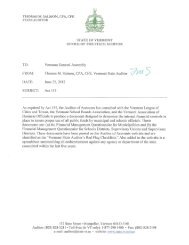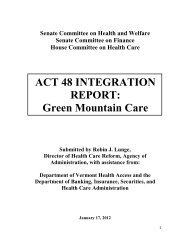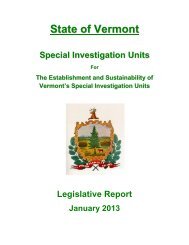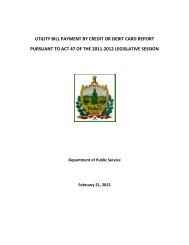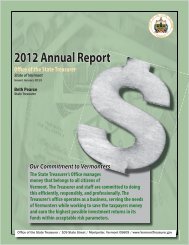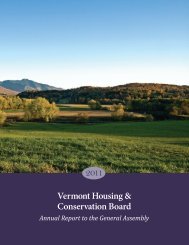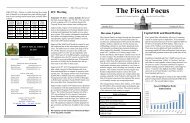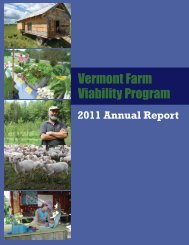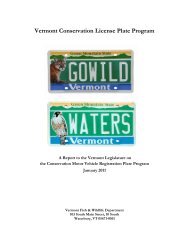Wildlife Management Area Report - Vermont Fish & Wildlife
Wildlife Management Area Report - Vermont Fish & Wildlife
Wildlife Management Area Report - Vermont Fish & Wildlife
You also want an ePaper? Increase the reach of your titles
YUMPU automatically turns print PDFs into web optimized ePapers that Google loves.
<strong>Vermont</strong> <strong>Fish</strong> & <strong>Wildlife</strong> Department<br />
<strong>Wildlife</strong> <strong>Management</strong> <strong>Area</strong> <strong>Report</strong><br />
Agency of Natural Resources<br />
Protect, Respect, Enjoy<br />
2012 Annual <strong>Report</strong><br />
<strong>Wildlife</strong> <strong>Management</strong> <strong>Area</strong>s as Outdoor Classrooms and Stewardship<br />
Demonstration Sites<br />
By Paul Hamelin<br />
It’s often said, “A picture is worth a thousand words.” But for<br />
natural resource education it’s infinitely better to be out on<br />
the actual site, absorbing the smells, sounds, and sights of the<br />
landscape. Standing knee deep in snow under a hemlock tree<br />
in the crackling cold of a February morning, one has a much<br />
greater appreciation for the struggles of a white-tailed deer<br />
trying to outlast the challenges of winter on a diet of twigs.<br />
In addition to their primary role of conserving wildlife habitat<br />
and providing wildlife-based recreation, a little known role of<br />
<strong>Wildlife</strong> <strong>Management</strong> <strong>Area</strong>s (WMA) is their accessibility as<br />
outdoor classrooms. A place where students can experience<br />
the natural world and observe the results of thoughtful land<br />
stewardship.<br />
The habitat diversity and statewide distribution of these lands<br />
make them ideal places to observe wildlife sign, animals, plants,<br />
and habitats. Throughout the state these lands are used for<br />
informal education through birding tours and guided wildlife<br />
tracking trips, and for formal activities such as college field<br />
trips, graduate research projects, and college natural resource<br />
studies. Two examples of this use are found in the <strong>Vermont</strong><br />
<strong>Fish</strong> & <strong>Wildlife</strong> Department’s (VFWD) <strong>Wildlife</strong> <strong>Management</strong><br />
for Educators Course, an effort to educate teachers in the<br />
principles of wildlife management, and, in its collaboration with<br />
the Northeast Section of The <strong>Wildlife</strong> Society (TWS), to offer<br />
the <strong>Wildlife</strong> Field Course for college students striving to become<br />
natural resource management professionals.<br />
For 27 years, the VFWD has offered a college level field course<br />
that gets educators out into <strong>Vermont</strong>’s streams, forests and<br />
wetlands for a week with some of the state’s leading experts<br />
in natural resource disciplines. The Steam Mill Brook WMA<br />
has played a prominent role in the “teacher’s course,” offering<br />
a diversity of habitats where teachers learn about wildlife sign<br />
and habitat concepts, beaver wetland ecology, and habitat<br />
management techniques.<br />
The <strong>Wildlife</strong> Field Course provides future natural resource<br />
managers with two weeks of instruction in a wide variety of<br />
topics, ranging from basic navigation skills, flora and fauna<br />
WMAs have been an outdoor classroom for the <strong>Wildlife</strong><br />
<strong>Management</strong> for Educators Course for 27 years. VFWD Photo.<br />
identification, and habitat inventory techniques, to wildlife<br />
sampling, inventory, and chemical immobilization methods.<br />
Following the initial session of the <strong>Wildlife</strong> Field Course in<br />
2009, organizer-instructor John E. McDonald noted in the<br />
Summer 2009 issue of the Northeast Section of The <strong>Wildlife</strong><br />
Society Newsletter that “The majority of the field exercises were<br />
conducted at the Bird Mountain <strong>Wildlife</strong> <strong>Management</strong> <strong>Area</strong>, a<br />
property of the <strong>Vermont</strong> <strong>Fish</strong> & <strong>Wildlife</strong> Department. Bird<br />
Mountain was an ideal setting for the course, with a variety of<br />
habitats and forest age classes, good access, and even a pair of<br />
nesting peregrine falcons.”<br />
The habitat management practices implemented on WMAs<br />
make them excellent sites to demonstrate exemplary habitat,<br />
forestry, and land stewardship practices. WMA management<br />
activities are guided by long range management plans and a<br />
variety of policies designed to protect and conserve water<br />
quality, wetlands, rare species, unique or fragile habitats and<br />
natural communities, and cultural resources, in addition to<br />
managing for game species and related public interests. Many<br />
WMAs have hosted workshops held by VFWD staff in<br />
collaboration with VT Coverts, USDA-Natural Resources<br />
continued on page 2<br />
1
sensitive loon nesting areas. Temporary signage has been placed<br />
at several highly visible timber harvests to educate visitors about<br />
the purpose of the harvest and the wildlife it was prescribed to<br />
benefit.<br />
Workshops on the care of wild apple trees are popular WMA<br />
events, as indicated by attendance at this collaboration<br />
between VFWD, VT FPR, and VT Coverts on Whitney-Hospital<br />
Creek WMA. Photo: David Sausville.<br />
WMAs as Outdoor Classrooms continued from page 1<br />
Conservation Service, VT Department of Forests, Parks and<br />
Recreation (FPR), and other partners.<br />
These workshops are designed to educate students and private<br />
landowners in habitat improvement techniques such as apple<br />
or mast tree enhancement, deer wintering area management,<br />
aspen management for upland game birds, conifer management<br />
for snowshoe hares, grassland bird habitat management, and<br />
herbaceous opening development. Best management practices<br />
such as installing beaver wetland water control structures<br />
demonstrate how impacts to infrastructure can be mitigated<br />
while retaining beaver wetlands and their associated values.<br />
During timber harvests prescribed to improve wildlife habitat,<br />
practices such as retaining snags and den trees, use of portable<br />
skidder bridges instead of poled fords, and retention of<br />
forested buffers on streams and vernal pools exhibit proper land<br />
stewardship practices to loggers and the public.<br />
On WMA agricultural landscapes comparable practices include<br />
planting trees to create riparian buffers, retaining un-mowed hay<br />
buffers around wetlands and streambanks, and using delayed<br />
mowing to protect grassland bird nests. A recent initiative<br />
intended to improve aquatic habitat has provided staff training<br />
and emphasized the importance of replacing culverts with<br />
bridges when applicable to improve fish passage.<br />
Many of the habitat practices and educational opportunities on<br />
WMAs are not apparent to the casual observer, so temporary<br />
and permanent interpretive kiosks and signage are placed<br />
at WMA access points to educate visitors. For example,<br />
interpretive signs at the Dead Creek WMA informs visitors<br />
about the migration of snow geese that visit in October. Similar<br />
panels are planned for the moose viewing platform at West<br />
Mountain WMA to educate viewers about moose biology and<br />
management, and a kiosk to educate viewers about the migratory<br />
steelhead trout leaping the falls at Willoughby Falls WMA is<br />
planned for 2012. Signage on many WMA kiosks is maintained<br />
to educate users on topics ranging from land stewardship to<br />
WMAs throughout <strong>Vermont</strong> are used routinely as effective<br />
classrooms in many fashions for effective, successful, stateof-the-art<br />
wildlife and habitat management, stewardship and<br />
research. From Dead Creek Days, one of the most popular<br />
annual celebrations of <strong>Vermont</strong>’s natural heritage held each year<br />
at the Dead Creek WMA, to the courses, trainings and kiosks,<br />
the VFWD connects citizens of all ages with the land through<br />
outdoor education on our WMAs.<br />
WMA Research and Education Highlights<br />
••<br />
For the past two decades, a professor at Norwich<br />
University has researched the ecology of the Canada jay at<br />
Victory Basin WMA.<br />
••<br />
In 2004, a University of <strong>Vermont</strong> ecology class used<br />
Moose Bog in Wenlock WMA as the focus of an intensive<br />
field course.<br />
••<br />
Small mammal abundance and distribution has been<br />
studied at several WMAs by University of <strong>Vermont</strong> wildlife<br />
researchers.<br />
••<br />
Research on the effectiveness of scat detection dogs to<br />
confirm wildlife presence has been conducted on Steam<br />
Mill Brook WMA, Lewis Creek WMA, and West Mountain<br />
WMA.<br />
••<br />
Dead Creek WMA hosted the 10th annual Dead Creek<br />
<strong>Wildlife</strong> Day, which featured numerous educational<br />
activities such bird banding demonstrations, live wildlife<br />
presentations, and nature walks.<br />
••<br />
Steam Mill Brook WMA hosted a tour for <strong>Vermont</strong><br />
legislators to exhibit active timber harvesting techniques<br />
and the benefits of prescribed timber harvest for habitat<br />
management.<br />
WMAs host many research and education activities, including<br />
a long term study of gray jay ecology at Victory Basin WMA.<br />
Photo: Stephen Mason<br />
2
WMAs at a Glance<br />
The VFWD manages 86 WMAs and numerous riparian parcels totaling over 130,150 acres.<br />
These lands play an important role in meeting the VFWD’s mission. <strong>Management</strong> of<br />
these areas emphasizes the conservation of fish, wildlife and their habitats, while providing<br />
important public access for hunting, fishing, trapping and other fish and wildlife-based<br />
activities.<br />
The VFWD has purchased<br />
WMAs using several funding<br />
sources, including funds from<br />
hunting license sales, <strong>Vermont</strong><br />
Waterfowl Funds from the<br />
sale of state duck stamps,<br />
US <strong>Fish</strong> & <strong>Wildlife</strong> Service<br />
(USFWS) Federal Aid in <strong>Wildlife</strong><br />
Restoration (Pittman-Robertson)<br />
Fund, <strong>Vermont</strong> Housing and<br />
Conservation Board, and the<br />
Land and Water Conservation<br />
Fund. <strong>Management</strong> and<br />
administration of all WMAs<br />
are primarily paid for through<br />
USFWS Federal Aid in <strong>Wildlife</strong><br />
Restoration Funds. Each year,<br />
at least 16 VFWD biologists<br />
and Specialists work on WMA<br />
management and administration.<br />
Aerial photo of mowed hay fields at Willoughby Falls WMA<br />
illustrates the exemplary practice of retaining an un-cut hay<br />
buffer to maintain water quality (green between yellow line<br />
and river) versus leaving no buffer (red line at wetland edge).<br />
Technical assistance from our colleagues in the <strong>Vermont</strong> Department of Forests, Parks, and<br />
Recreation (FPR) is essential for completing WMA long range management planning, property<br />
administration, and habitat management projects. <strong>Wildlife</strong> habitat enhancement activities are<br />
conducted through commercial and noncommercial means to provide the rich diversity of<br />
habitat types and forest ages necessary to meet the needs of many wildlife species.<br />
The management of WMAs is guided by Long Range <strong>Management</strong> Plans (LRMP). LRMPs<br />
are based on a thorough natural resources inventory and public input. <strong>Management</strong> activities<br />
focus on providing a diversity of fish and wildlife habitat as well as quality opportunities for<br />
fish and wildlife-based outdoor activities.<br />
Most of the programs<br />
described in this report are<br />
funded through the Federal<br />
Aid in <strong>Wildlife</strong> Restoration<br />
Program. This program<br />
was initiated in 1937 as<br />
the Federal Aid in <strong>Wildlife</strong><br />
Act and created a system<br />
whereby taxes are paid on<br />
firearms, ammunition and<br />
archery equipment by the<br />
public who hunts. Today this<br />
excise tax generates more<br />
than one hundred million<br />
dollars each year that are<br />
dedicated to state wildlife<br />
restoration and management<br />
projects across the United<br />
States. The state of <strong>Vermont</strong><br />
uses these monies for<br />
acquiring land, and for<br />
restoring and managing<br />
wildlife. These excise tax<br />
dollars, coupled with state<br />
hunting license fees, have<br />
been the predominant<br />
source of funding for the<br />
successful restoration and<br />
management of <strong>Vermont</strong>’s<br />
wildlife resources.<br />
WMA management is primarily focused on providing a diversity of fish and wildlife habitat<br />
as well as quality opportunities for fish and wildlife based outdoor activities.<br />
Photo: Wetland at West Mountain WMA by Bob Zaino<br />
Conserving fish, wildlife, plants<br />
and their habitats for the<br />
people of <strong>Vermont</strong>.<br />
3
Non-commercial <strong>Wildlife</strong> Habitat<br />
<strong>Management</strong><br />
Non-commercial habitat management activities includes<br />
methods other than timber harvest. In most cases, VFWD<br />
wildlife biologists, VT Department of Forest, Parks and<br />
Recreation staff, volunteers, or private contractors perform these<br />
management activities.<br />
The following non-commercial wildlife management activities<br />
were conducted during the 2011 calendar year:<br />
••<br />
Installed and maintained 3 beaver baffle water control<br />
structures<br />
••<br />
Mowed or maintained 955 acres of grassland and cropland<br />
••<br />
Cleared competing brush from 127 fruit trees<br />
••<br />
Released 11.5 acres of apples and young oak trees<br />
••<br />
Planted 350 fruit or mast (nut bearing) trees<br />
••<br />
Planted 200 white pine seedlings to restore pine and<br />
increase diversity in Victory Basin WMA.<br />
••<br />
Maintained 104 acres of old field habitat through<br />
controlled burning (31 acres) and brush mowing (73 acres)<br />
••<br />
Planted 180 trees on 2 acres of streambank for riparian<br />
restoration<br />
••<br />
Managed water levels on 2,341 acres of wetland habitat for<br />
waterfowl and other wetland species<br />
••<br />
Maintained 643 waterfowl nest structures and installed 7<br />
new structures<br />
••<br />
Installed 2 osprey nesting platforms<br />
••<br />
Treated 22 acres to control invasive plants<br />
••<br />
Conducted 28 habitat, wildlife and public use inventories<br />
on 22 WMAs<br />
Commercial <strong>Wildlife</strong> Habitat <strong>Management</strong><br />
Commercial wildlife habitat management activities can enhance<br />
wildlife habitat while removing merchantable wood products or<br />
agricultural crops. Commercial logging operations also improve<br />
public access for fish and wildlife based activities by helping the<br />
VFWD develop or maintain WMA roads, culverts, bridges, and<br />
herbaceous openings.<br />
Revenue generated by the commercial sale of timber and hay<br />
on WMAs is reinvested into the management or acquisition<br />
of these lands. Timber sale receipts from commercial forest<br />
management activities on WMAs have increased in recent years.<br />
A summary of WMA timber harvests for the 5-year period<br />
FY07-FY11 is provided in Table 1.<br />
Table 2 reports the commercial wildlife habitat management<br />
activities on WMAs in FY11. Variations in harvesting volumes<br />
across different regions of the state are a result of disparities in<br />
State-owned timber acreage and accessibility on WMAs, staffing<br />
levels, stand conditions, and work priorities. Table 3 indicates the<br />
acreage and minimum projected income for six timber harvests<br />
that were active, sold, or about to be sold on six WMAs as of<br />
January 1, 2012.<br />
Commercial agriculture was conducted using leases on 960 acres<br />
in four districts in 2011, generating $11,139 in revenue to use<br />
as match for federal funding for WMA management. As with<br />
timber harvesting, this activity contributes to the local economy<br />
and maintains <strong>Vermont</strong>’s working landscape while providing<br />
habitats for many species of wildlife including waterfowl, deer,<br />
bear, turkeys, and many more.<br />
Maintenance of wild apple trees on WMAs, along with<br />
planting nut-bearing species and improving the vigor of<br />
older fruit and nut trees by selective thinning, yields essential<br />
fall food for turkeys, deer, bear and many other birds and<br />
mammals. Photo VFWD<br />
<strong>Management</strong> for habitat diversity presents excellent wildlife<br />
viewing opportunities on WMAs, fostering enjoyment of<br />
species such as this ermine.<br />
Photo: Toby Alexander, USDA NRCS<br />
4
Table 1. <strong>Wildlife</strong> Habitat Timber Harvests on VFWD WMAs FY07-11 a<br />
FY07 FY08 FY09 FY10 FY11 5-Year Totals<br />
Fee Acres Harvested (#) 444 659 624 565 404 2,696<br />
Board Feet (MBF) 898 891 992 782 739 4,302<br />
Cords (#) 2,473 3,008 3,477 1,939 3,215 14,112<br />
Program Income ($) c $180,487 $294,582 $268,200 $205,193 $200,748 $1,149,210<br />
Non-fee Acres Harvest (#) b 110 105 300 500 700 1,715<br />
# of Active Timber Sales 12 12 11 8 14 N/A: Timber Harvests Span<br />
Several Years<br />
Table 2. <strong>Wildlife</strong> Habitat Timber Harvests on VFWD WMAs - FY11 a<br />
District I<br />
Springfield<br />
District II<br />
Rutland<br />
District III<br />
Barre<br />
District IV<br />
Essex Jct.<br />
District V<br />
St. Johnsbury<br />
State<br />
Totals<br />
Fee Acres Harvested (#) 0 214 0 120 114 448<br />
Board Feet (MBF) 0 314 0 431 745+<br />
Cords (#) 0 903 0 1,945 2,848+<br />
Program Income ($) c $4,984 $128,860 $0 $49,540 $96,513 $279,897<br />
Non-fee Acres Harvested (#) b 1,200 0 0 0 0 1,200<br />
a Includes pre-harvest payments;<br />
b Timber rights privately owned;<br />
c Revenues generated on WMAs go back into the management of<br />
these properties.<br />
Table 3. <strong>Wildlife</strong> Habitat Timber Harvests Active, Sold, or Ready to Sell on Six VFWD WMAs as of Jan. 1, 2012<br />
District Number of Sales Clear-Cut Acres Selective Acres Acres Total Income Projection*<br />
Springfield 2 18 48 66 $29,029<br />
Rutland 2 31 59 90 $34,353<br />
Barre 1 0 79 79 $13,948<br />
Essex 0 0 0 0 $0<br />
St. Johnsbury 1 0 50 50 $22,100<br />
Totals 6 49 236 285 $99,430<br />
*Based on actual price of purchased sales or minimum acceptable bid for sales ready to sell. Projection = payment amount remaining in active<br />
sales + uncut sold sales + prospectus minimum bids. Revenue subject to winter operating conditions; total income may not be realized until after<br />
June 30, 2014.<br />
The VFWD mission includes the conservation of plants and<br />
their habitats. A 2011 WMA inventory verified that these<br />
state-threatened sweet coltsfoot plants belong to one of the<br />
two largest known populations in the state. Photo: Bob Popp<br />
Temporary<br />
interpretive<br />
signage<br />
is being<br />
installed on<br />
some WMAs<br />
to inform the<br />
public about<br />
the goals of<br />
recent timber<br />
harvests.<br />
Photo:<br />
Paul Hamelin<br />
5
In the Spotlight: Sandbar WMA<br />
By Bill Crenshaw<br />
The Sandbar <strong>Wildlife</strong> <strong>Management</strong> <strong>Area</strong> in Milton and Colchester was acquired by the VFWD in<br />
1920, making it <strong>Vermont</strong>’s oldest WMA. It consists of 1,560 acres of mostly river delta wetlands<br />
located at the mouth of the Lamoille River. These wetlands represent a rich mix of floodplain<br />
forest and emergent marsh, including one of the finest wild rice stands in the state. Water levels<br />
in these wetlands are controlled primarily by the level of Lake Champlain.<br />
Several hundred mallards and wood ducks are banded<br />
on the Sandbar WMA annually. Photo: Bill Crenshaw<br />
Sandbar has long been recognized<br />
as an important breeding and<br />
stopover area for waterfowl and<br />
other aquatic birds. Most of the<br />
WMA is set aside as a waterfowl<br />
refuge to provide resting and<br />
feeding areas during breeding<br />
and migration periods. Over<br />
100 waterfowl nesting boxes are<br />
maintained on the area by the VFWD, which are utilized by wood ducks,<br />
goldeneyes and hooded mergansers. These wetlands are also used for<br />
nesting by mallards and Canada geese. During fall and spring migration,<br />
the refuge also receives heavy use by these species as well black ducks,<br />
ring-necked ducks and green-winged teal. Several hundred mallards and<br />
wood ducks are banded on the Sandbar WMA annually.<br />
Sandbar is also home to more than 10 breeding pairs of osprey. In<br />
recent years, a nesting colony of great blue herons has become<br />
established in the floodplain forest. Pied-billed grebes, sora rails and<br />
common moorhens can also be found in the wetlands. During the<br />
spring, the floodplain forest attracts migrating warblers and other song<br />
birds. Bald eagles and northern harriers are also commonly seen on the<br />
area.<br />
The Sandbar wetlands provide important habitat to a variety of reptiles<br />
and amphibians including the northern leopard frog, green frog, gray<br />
tree frog, bullfrog, American toad, and spring peeper. Turtle species<br />
include painted turtle, snapping turtle, map turtle, and the state-listed<br />
spiny soft-shelled turtle. Many species of warm-water fish, including<br />
largemouth bass, longnose gar, and bowfin spawn and feed in these<br />
wetlands.<br />
About 30% of the area consists of forested uplands and old fields,<br />
including an excellent example of a pine/oak sandplain forest<br />
community. This forest community used to be more<br />
common in the Champlain Valley but, due to clearing<br />
for agriculture and development, it’s now extremely<br />
rare. Dominated by red oak and pitch pine, it’s<br />
believed to be a fire-dependent natural community.<br />
In 2010, the VFWD and the <strong>Vermont</strong> Department of<br />
Forest Parks and Recreation conducted a prescribed<br />
burn on a 12-acre parcel to control nuisance exotic<br />
species and prepare the soil for pitch pine and oak<br />
regeneration.<br />
The forested uplands on the east side of Route 2<br />
are comprised of a mixture of red and white oak,<br />
sugar and red maple, shagbark hickory, white pine,<br />
At least 10 osprey pairs nest on Sandbar WMA every<br />
summer, making them one of the area’s most visible wildlife<br />
species. Photo: Alan Irwin<br />
The shy sora<br />
is rarely seen,<br />
as it prefers<br />
concealment in<br />
the dense thicket<br />
of marsh plants,<br />
but its whinny-like<br />
call is often heard<br />
by early morning<br />
marsh visitors.<br />
Photo: USFWS<br />
6
Property Administration<br />
An essential component of any land management program is<br />
the maintenance of property boundaries and infrastructure, such<br />
as roads, bridges, and signs. These efforts are essential for the<br />
VFWD to meet its goals for habitat management and public use.<br />
The 86 WMAs routinely require boundary line surveying and<br />
maintenance, building maintenance, signage, trash removal, and<br />
responses to encroachments and other trespasses.<br />
Wild rice (inset) growing in the Lamoille river delta marsh<br />
makes Sandbar WMA a highly attractive feeding area for<br />
migrating waterfowl to refuel on their journey south.<br />
Photo: Bill Crenshaw<br />
hemlock, aspen and grey birch. This area is managed to<br />
provide both young forest and mature forest habitat for<br />
wildlife. Several old fields are managed for nesting waterfowl,<br />
turkeys and grassland birds through periodic mowing. These<br />
fields also provide important cover for deer fawns during late<br />
May and June.<br />
Since much of the Sandbar <strong>Wildlife</strong> <strong>Management</strong> <strong>Area</strong> is a<br />
wildlife refuge and closed to public use, the best way to enjoy<br />
the wetlands is with a boat, canoe or kayak along the Lamoille<br />
River. Two access areas, one along the Lamoille River and the<br />
other across from the Sandbar State Park, provide access to<br />
the river and Lake Champlain. Make sure to stay outside the<br />
refuge signs and enjoy the wildlife with binoculars from a<br />
distance along the river or the lake. The forested area east of<br />
Route 2 and west of Bear Trap Road is open to the public for<br />
wildlife-based recreation.<br />
The following maintenance activities were completed on WMAs<br />
during the 2011 calendar year:<br />
••<br />
Installed or repaired 34 culverts or bridges<br />
••<br />
Constructed 2 new parking areas<br />
••<br />
Maintained 5 buildings<br />
••<br />
Mowed/maintained 36 dams, dikes and levees<br />
••<br />
Maintained 51 miles of forest roads<br />
••<br />
Removed 750 feet of defunct fence<br />
••<br />
Improved/maintained 18 parking areas<br />
••<br />
Maintained 25 miles of property boundary<br />
••<br />
Installed 2 new gates and repaired 4<br />
••<br />
Conducted 4 cultural resource reviews<br />
••<br />
Assessed 11 parcels for potential VFWD acquisition<br />
to protect habitat and public access for wildlife based<br />
recreation<br />
••<br />
Addressed 93 property administration issues<br />
(encroachments etc.)<br />
••<br />
Conducted 27 presentations or media releases<br />
••<br />
Hosted 2 public input meetings and finalized 2 Long Range<br />
<strong>Management</strong> Plans<br />
Controlled burning was conducted at Sandbar WMA to<br />
improve habitat quality and control invasive honeysuckle in<br />
the rare pine/oak sandplain forest. Photo: John Gobeille<br />
Tropical Storm Irene caused extensive damage on several<br />
WMAs, including South America Pond Road on West<br />
Mountain WMA. Photo: Paul Hamelin<br />
7
Land Acquisition<br />
WMA land acquisition is an important element in achieving<br />
the VFWD’s mission. Parcels are evaluated based on existing<br />
habitat values and restoration potential, rare or exemplary natural<br />
communities, and public access values for wildlife- based recreation<br />
on land or water. Some parcels are acquired to improve access<br />
to existing WMAs, or to ensure that existing values are not<br />
compromised by adjacent developments.<br />
WMA land acquisition is executed by VFWD staff and is assisted<br />
by ANR Lands Administration staff. Many land acquisition<br />
projects are made possible with the aid of conservation partners,<br />
notably <strong>Vermont</strong> Land Trust Inc., The Nature Conservancy, Ducks<br />
Unlimited, and the Trust for Public Land. The acquisition process<br />
is comprehensive, involving assessment of attributes, real estate<br />
appraisal, property survey, town approval, funding approval, ANR<br />
and Gubernatorial approval, and other administrative procedures,<br />
so only a small number of potential parcels meet all of the criteria<br />
and are actually acquired.<br />
Ten parcels ranging in size from 16 to 410 acres are currently under<br />
consideration and in various stages of acquisition. We anticipate<br />
closing on at least five of these properties in 2012. In 2011 we<br />
acquired the following six parcels in fee, totaling 481.3 +/- acres.<br />
Steam Mill Brook WMA, Walden, VT — 5 acres<br />
Located in Walden near the southwest boundary of Steam Mill<br />
Brook WMA, the property is mostly beaver pond and associated<br />
wetland with approximately 1,000 feet of road frontage. Wood<br />
ducks nest in boxes maintained on the pond, other duck species<br />
use the wetland during spring and fall migration, northern harriers<br />
have been observed feeding over the sedge meadows, and a<br />
host of other bird, mammal, reptile and amphibian species use<br />
this valuable wetland. The property also includes a significant<br />
natural community, listed as an intermediate fen. Acquisition of<br />
this parcel buffers the WMA against impacts from development.<br />
Public access is enhanced due to the proximity of the property to a<br />
town road.<br />
South Stream WMA, Pownal, VT — 15 acres<br />
Addition of this 15-acre parcel to the South Stream WMA<br />
provides improved public access for hunting, trapping, wildlife<br />
viewing, and the conservation of significant wildlife habitat. A<br />
state-significant example of a Calcareous Red Maple-Tamarack<br />
Swamp straddles the boundary of the WMA. Acquisition of this<br />
property significantly improves the ability to manage the WMA and<br />
improve public access in an area valued by waterfowl hunters and<br />
other members of the public that enjoy this area.<br />
Little Otter Creek WMA, Ferrisburgh, VT — 27 acres<br />
The addition of this 27-acre parcel to the Little Otter Creek WMA<br />
provides permanent protection of public access for hunting,<br />
trapping, wildlife viewing, and the conservation of significant<br />
wildlife habitat. The 27 acre parcel is in the process of reverting<br />
to forest and contains significant frontage on Little Otter Creek.<br />
There is significant value in owning this acreage to maintain public<br />
access for wildlife-based activities, in addition to being able to<br />
enhance the restoration of the forest through invasive species<br />
management.<br />
8<br />
A recent acquisition on Whitney Creek in Addison includes a<br />
highly productive VFWD waterfowl banding site, along with<br />
200+ acres of outstanding wetland and upland wildlife habitat.<br />
Photo: Bill Crenshaw<br />
Atherton Meadows WMA, Whitingham, VT — 147.7 acres<br />
This parcel adds 147.7 acres to the existing Atherton Meadows<br />
WMA, ensuring that wildlife such as white-tailed deer, black<br />
bear, mink, beaver and osprey have suitable habitat over time.<br />
Approximately 50 acres of the property were observed to be<br />
deer wintering area. There are also numerous vernal pools, seeps,<br />
permanent and seasonal streams, as well as a major wetland<br />
complex on the north side of the parcel.<br />
Whitney-Hospital Creek WMA, Addison, VT — 207.8 acres<br />
The parcel consists of 65 acres of Lake Champlain influenced<br />
wetlands (emergent marsh, button bush swamp, and floodplain<br />
forest) and 142.8 acres of uplands. The uplands consist of two<br />
reverting pastures and small patches of clay plain forest. This<br />
area is rich in fish and wildlife resources. Whitney Creek is heavily<br />
used by fishermen in the spring and by waterfowl, deer, and<br />
turkey hunters in the fall. The wetlands are important spawning<br />
areas for warm water fish (e.g., Northern Pike, Large-mouth Bass,<br />
Brown Bullhead, White Crappie, Bowfin, and Channel Catfish,<br />
etc.) originating from Lake Champlain. We were fortunate to close<br />
on a unique, and probably one time, opportunity to guarantee<br />
public hunting, fishing, trapping, and habitat management, and<br />
to eliminate the potential development of two building sites that<br />
could seriously impact the public use of this area. This parcel<br />
represents a key component to the Whitney/Hospital Creek WMA.<br />
Athens Dome Wetland Complex, Athens and Grafton, VT<br />
— 78.8 acres<br />
The VFWD and The Nature Conservancy are collaborating to<br />
protect +/-560 acres as a new WMA where numerous beaverinfluenced<br />
wetlands provide ideal habitat for the federallyendangered<br />
Northeastern bulrush (Scirpus ancistrochaetus). The<br />
Athens Dome Wetland Complex Project located in the towns of<br />
Athens and Grafton, VT is comprised of undeveloped and intact<br />
forest land that supports vital wildlife habitat, state-significant<br />
wetlands, stream frontage, traditional recreational opportunities,<br />
and scenic viewpoints. This wetland complex includes two<br />
documented occurrences of Northeastern bulrush, and supports<br />
numerous wetlands containing ideal habitat for the Northeastern<br />
bulrush. We closed on one of the three properties that make up<br />
this project in 2011.




